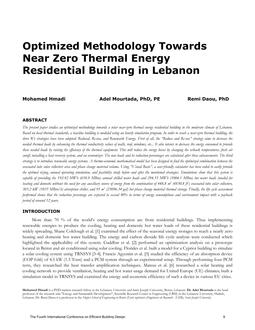Description
The present paper studies an optimized methodology towards a solar near-zero thermal energy residential building in the moderate climate of Lebanon. Based on local thermal standards, a baseline building is modeled using an hourly simulation program. In order to reach a near-zero thermal building, the three R’s strategies have been adopted: Reduced, Re-use, and Renewable Energy. First of all, the “Reduce and Re-use” strategy aims to decrease the needed thermal loads by enhancing the thermal conductivity values of walls, roof, windows, etc… It also intents to decrease the energy consumed to provide these needed loads by raising the efficiency of the thermal equipment. This will reduce the energy losses by changing the setback temperatures, fresh air cutoff, installing a heat recovery system, and an economizer. The new loads and its reduction percentages are calculated after these enhancements. The third strategy is to introduce renewable energy systems. A thermo-economic mathematical model has been designed to find the optimized combination between the evacuated tube solar collectors area and phase change material volume. Using “Visual Basic”, a user-friendly calculator has been coded to easily provide the optimal sizing, annual operating simulation, and feasibility study before and after the mentioned strategies. Simulations show that this system is capable of providing the 192.92 MWh (658.9 MBtu) annual chilled water loads and 294.35 MWh (1004.1 MBtu) hot water loads (needed for heating and domestic without the need for any auxiliary source of energy from the combination of 448.8 m2 (4830.8 ft2) evacuated tube solar collectors, 303.2 kW (1035 MBtu/h) absorption chiller, and 95 m3 (25096.34 gal) hot phase change material thermal storage. Finally, the life cycle assessment performed shows that the reduction percentage are expected to exceed 90% in terms of energy consumptions and environment impact with a payback period of around 12 years.
Citation: 4th Intl Conf: Efficient Bldg Design
Product Details
- Published:
- 2020
- Number of Pages:
- 8
- Units of Measure:
- Dual
- File Size:
- 1 file , 1.5 MB
- Product Code(s):
- D-ICEB20-02




